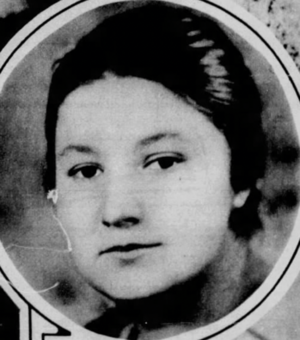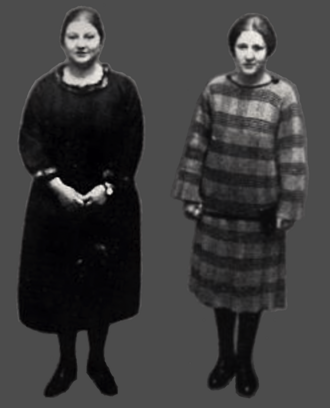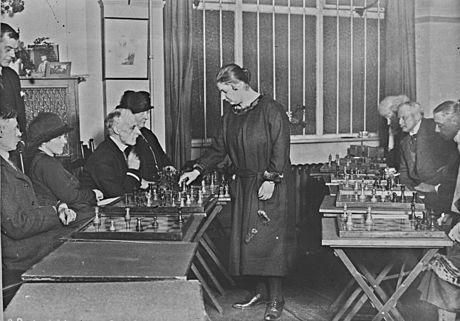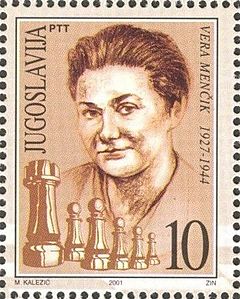Vera Menchik facts for kids
Quick facts for kids Vera Menchik |
|
|---|---|

Menchik in 1927
|
|
| Full name | Vera Francevna Mencikova |
| Country | Russia (before 1928) Czechoslovakia (1930–1937) England (1938–1944) |
| Born | 16 February 1906 Moscow, Russian Empire |
| Died | 26 June 1944 (aged 38) Clapham, London, United Kingdom |
| Women's World Champion | 1927–1944 |
Vera Francevna Mencikova (Russian: Вера Францевна Менчик, Vera Frantsevna Menchik; Czech: Věra Menčíková; 16 February 1906 – 26 June 1944) was a famous chess player. She was born in Russia but lived mostly in England. Vera was the very first Women's World Chess Champion. She held this title from 1927 until 1944. This makes her the longest-reigning women's champion ever! She won the world championship eight times, which is more than anyone else. Only Emanuel Lasker was a world champion for a longer time.
Vera was born in Moscow. Her father was Czech, and her mother was English. She started playing chess tournaments at school when she was 14. This happened after her family had to move to a different school during the Russian Revolution. Because of the revolution, her family left Russia. Vera moved to Hastings, England, in 1921. She joined the Hastings Chess Club in 1923. There, she trained with James Drewitt, the club champion, and Géza Maróczy, a top player.
Vera quickly became the best female player in England. She beat the British women's champion, Edith Charlotte Price, in two matches in 1925. Two years later, she won the first Women's World Chess Championship in 1927. A year later, she was the first woman to play in master-level tournaments. After doing well at Ramsgate in 1929, she was often invited to these big events. Her best result at the Hastings Premier tournament was in 1931/32. She beat future world champion Max Euwe and Mir Sultan Khan there. She finished in joint fifth place out of ten players.
In 1937, Vera was already a five-time Women's World Champion. She played and won the first-ever Women's World Championship match. She played against Sonja Graf, who was the second-best female player at the time. One of her last big wins was a match against Jacques Mieses in 1942. Vera was still playing chess when she died in 1944. Her home was hit by a V-1 flying bomb during the Second World War.
Vera Menchik was the strongest female chess player before the war. She was the only woman who played at the master level. She won at least 59 games in a row at the Women's World Championship tournaments. She even beat male players like Max Euwe twice. She also had a winning record against George Thomas, who became an International Master (IM). Any master player Vera defeated became a "member" of the Vera Menchik Club. This club included six players who later became Grandmasters (GM). The trophy for the winning team at the Women's Chess Olympiad is called the Vera Menchik Cup. It is named in her honor.
Contents
Early Life and Chess Beginnings
Vera Mencikova was born on February 16, 1906, in Moscow, Russia. Her mother, Olga, was English, and her father, František Menčík, was Czech. Vera had a younger sister named Olga, who also became a chess player. Vera's parents worked for rich estate owners. Her mother was a governess, teaching the children. Her father managed the estates and later owned a mill. The family lived in a large apartment and had a good life.
Vera learned to play chess from her father when she was nine. When she was eleven, the Russian Revolution started in 1917. This changed her family's life. They had to share their home with poorer people. Vera moved from a private girls' school to a public school. Her father's mill was taken by the government. At her new school, students started a chess club. Vera joined the club and played her first tournament there at age 14. She was the only girl playing against other students and teachers. She said this tournament "gave birth to [her] sporting spirit."
In 1921, Vera left Russia with her mother and sister. They moved to Hastings, England, to live with her grandmother. Her father moved back to Bohemia. When Vera arrived in England, she only spoke Russian. She focused more on chess because she did not need to speak English to play.
Vera joined the Hastings Chess Club in March 1923 when she was 17. This club was famous for hosting the Hastings International Chess Congress, a tournament with top players. Her first coach was James Drewitt, the club champion. Later that year, she took private lessons with Géza Maróczy. He was a Hungarian player who later became a Grandmaster (GM). This training was special because few female players had formal coaching then. Vera said Maróczy inspired her to play at a higher level.
Becoming a Chess Champion
First Tournaments and Rivalry
Vera started playing chess tournaments often in 1923. She played her first big tournament at the 1923/24 Hastings Christmas Congress. She drew a game against Edith Charlotte Price, who was the British women's champion.
A year later, Vera and Edith Price played often to see who was better. They played two five-game matches in 1925. Vera won both matches, showing she was the best female player in England. That August, Vera also finished second at the Stratford tournament. She beat George Thomas in one game. By the end of 1925, the Sussex Chess Association called Vera a "first class" player. She was the first woman to play in the Major section of the Christmas Congress.
Vera started getting attention from the media. She won the London Girls' Championship twice, in 1926 and 1927, with perfect scores. Many photographers came to see her. She even spoke on BBC Radio. Her sister, Olga, also did well in these championships. Vera won her first big open tournament, the Major-level reserve section, at the Christmas Congress in 1926. In 1927, she beat Abraham Baratz, her first win against an established master.
Winning the World Title
Vera's biggest win in 1927 was becoming the first Women's World Champion. She was 21 years old. The International Chess Federation (FIDE) held the first Chess Olympiad in July 1927. They decided to have a women's tournament at the same time. The winner would be the first FIDE Women's World Champion.
The tournament had 12 players from eight European countries. Vera won with a great score of 10½ out of 11 points. She only drew one game. She finished 1½ points ahead of the second-place player. She was 5 points ahead of Edith Price, who came in sixth.
Playing Against the Masters
First Master Events
Vera started playing in master-level events in 1928. Her first was in Scarborough. She showed she could compete at this high level. She got an even score of 4½ out of 9 points. Alexander Alekhine, the World Champion, said she was "without a doubt a phenomenon." Vera then regularly played in the main Premier tournament at the Hastings Christmas Congress.
In 1929, Vera had her best open tournament at Ramsgate. It was a team event between British and foreign players. Vera was on the foreign team, which included former World Champion José Raúl Capablanca. Vera scored 5 out of 7 points without losing a game. She shared second place with Akiba Rubinstein, a very strong player. This success made her famous. She started getting invitations to play in international tournaments.
She played in Paris and Carlsbad in Czechoslovakia later that year. The Carlsbad tournament was one of the strongest chess events since World War I. It had almost all the world's top players. Vera didn't do as well in these tournaments, but she did beat Edgard Colle in Paris. She also beat Albert Becker and Friedrich Sämisch in Carlsbad. Sämisch was one of the first players to get the Grandmaster title. Becker had joked that anyone Vera beat would join the "Vera Menchik Club." He became the first member when she beat him! Even with her low score, Alekhine said Vera had talent.
Defending Her Title and Big Wins
Vera defended her Women's World Championship title twice in 1930 and 1931. She won both times. In 1931, she had a perfect score of 8 out of 8. This was the start of a streak where she won four world championships in a row with perfect scores. That's 45 games without a loss or draw!
In 1930, Vera also became the Hastings Club champion. She beat Max Euwe at the Hastings Christmas Congress in both 1930/31 and 1931/32. Euwe was one of the best players in the world and later became World Champion. Vera's win over Euwe got attention worldwide. In 1931, she also won the Major Open section at the British Championship. She was undefeated, winning 9 out of 11 games.
Matches Against Sonja Graf
After Vera defended her title in 1933, she was challenged by Sonja Graf. Graf was a German player who also played in open tournaments. They played an unofficial match in 1934. Graf won the first game, but Vera won the next three to win the match.
They played a second, official match in 1937 for the world championship title. Vera won easily by a score of 11½ to 4½. Graf did not do well against Vera in the 1937 World Championship tournament either.
Vera also had success in other international tournaments. In 1934, she finished third at the Maribor tournament in Yugoslavia. She beat several players who later became International Masters. In 1935, Vera played in a big tournament in Moscow, her hometown. She didn't do well, but she did draw a game against Salo Flohr, a top player. This draw helped a Soviet player, Mikhail Botvinnik, share first place.
Last Years and Final Championship
After Vera married in 1937, she became a British citizen. She played for England in a match against Holland in 1938. Later that year, she was the first woman to play in the British Championship. She finished in seventh place.
Vera defended her world championship title for the last time in 1939 in Buenos Aires. Her amazing streak of 59 games without a loss or draw at these tournaments ended when she drew with Milda Lauberte. In the next round, she almost lost to Graf but managed to win. Vera won the tournament with 18 out of 19 points, two points ahead of Graf.
The 1939 Women's World Championship was the last time Vera could travel outside Britain. This was because the Second World War started during the tournament. She still played in some tournaments in England. In 1940, she finished third at the London Easter Congress. Two years later, she played a match against Jacques Mieses, a very old but still active player. Mieses was one of the first Grandmasters. Vera beat him 6½ to 3½. Vera was still playing chess right up until her death in 1944.
Vera's Playing Style
| This section uses algebraic notation to describe chess moves. |
Vera Menchik was a positional player. This means she focused on building a strong position slowly. She aimed to get a good endgame and avoid risky moves. Some experts compared her style to other strong players like Samuel Reshevsky. They said she was calm during games. She would sit without moving much.
Gideon Ståhlberg, a Grandmaster, praised her sportsmanship. He said Vera was relaxed whether she won or lost. She was always the first to congratulate an opponent who played well.
Vera liked to start games with 1.d4 (the Queen's Pawn Game) when she played with the white pieces. With the black pieces, she often used the French Defence (1.e4 e6) against 1.e4. She also used the Queen's Gambit Declined (1.d4 d5 2.c4 e6) against 1.d4. The French Defence was her most famous opening. She even gave talks about it. Her coaches helped her understand different parts of the game. Experts said she knew chess theory very well.
Vera Menchik's Legacy
Achievements and Impact
Vera Menchik was clearly the best female chess player before World War II. She was the first Women's World Chess Champion from 1927 until her death in 1944. Her reign of almost 17 years is the longest in women's chess history. Only Emanuel Lasker had a longer reign as a world champion.
Vera was the only woman accepted as a master during her time. Sonja Graf was the only other woman who played in high-level open tournaments. Vera had a very strong record against Graf, winning 15 games, losing 3, and drawing 5.
Vera never received a FIDE title like Grandmaster (GM) or International Master (IM). FIDE started giving these titles after her death in 1950. However, she is generally seen as an IM-strength player. She won or drew games against Max Euwe, who became a World Champion. Other World Champions like Capablanca and Alekhine praised her skill. Capablanca once said, "One. Her name is Vera Menchik... She played against me and she is very strong."
The Vera Menchik Club
Master-level players who lost to Vera Menchik were said to be "members" of the "Vera Menchik Club." This idea started at the Carlsbad tournament in 1929. A player named Albert Becker joked about it after Vera lost her first game. He said anyone she beat would join the club. Becker himself became the first member when Vera beat him in the third round!
The idea of the club became popular. Max Euwe and George Thomas, who had tough games against Vera, were even called "president" of the club.
Four of the first 27 players to become Grandmasters in 1950 were members of the Vera Menchik Club. These included Max Euwe, Jacques Mieses, Samuel Reshevsky, and Friedrich Sämisch. Many other strong players also became members. George Thomas was one of Vera's most frequent opponents. She had a winning record against him.
Women in Chess
When Vera first came to England, many more men played chess than women. Women usually played against other women. Some chess clubs did not even allow women to join. Vera was the first woman to play in the top international section of the Hastings Christmas Congress in 1928.
Vera had ties to England, Czechoslovakia, and Russia. But she was never fully recognized by any one country during her life. After her death, the Soviet Union tried the most to keep her legacy alive. They invited her to the Moscow tournament in 1935 hoping she would inspire Soviet women's chess. Later, a Soviet player wrote the first book about Vera.
The Soviet Union became the top country in women's chess after Vera's death. They started women's championships in 1932. After Vera's visit to Moscow, 5000 women tried to qualify for these championships. Soviet players won the next 15 Women's World Championships.
Vera's calm playing style led to a belief that women could not be strong attacking players. But in modern chess, this idea has changed. Strong female players like Nona Gaprindashvili and Judit Polgár are known for their aggressive styles. Judit Polgár is widely considered the best female chess player ever.
Honors and Memorials
Vera Menchik was inducted into the World Chess Hall of Fame in 2011. She was the first woman to receive this honor. When FIDE started the Women's Chess Olympiad in 1957, they named the championship trophy the Vera Menchik Cup. In 1994, FIDE made it the "Year of Vera Menchik" to mark 50 years since her death. Vera has also been on postage stamps in different countries.
Many chess tournaments are held in Vera's honor. The Hastings Chess Club hosted a junior tournament for young players. In Prague, Czech Republic, the DPP chess club hosts the Vera Menchik Memorial. This is an annual or bi-annual rapid chess tournament. In 2022, the English Chess Federation started the Caplin Menchik Memorial in London. This tournament helps female players earn titles like Woman International Master (WIM) and Woman Grandmaster (WGM).
Sadly, most of Vera's awards were lost when her home was destroyed. One of the few things that survived was a damaged gold medal. It honored her long reign as Women's World Champion. In 2022, The New York Times featured Vera in their "Overlooked" obituary series.
Personal Life
Vera Menchik earned money from chess. She gave chess lessons and worked as a chess editor for magazines. She also hosted events at chess clubs. During World War II, she became the director of the British National Chess Centre in London. However, the building was destroyed by bombing. After that, she joined the West London Chess Club. When chess lessons were less popular during the war, she also taught the card game bridge.
Vera was known for being friendly and interested in others. This made her popular and helped her get invited to tournaments. She enjoyed seeing plays and films, playing tennis, and modeling clay.
Family Life
Vera married Rufus Henry Streatfield Stevenson in October 1937. She was 31, and he was 59. She changed her name to Vera Stevenson but still used her birth name in chess competitions. Rufus was a pharmacist and a well-known chess organizer. He helped start county chess competitions and welcomed new players. He also worked for British Chess Magazine. Vera influenced the magazine to include more news about women's chess. Vera and Rufus were married for about five years until he died in 1943.
Vera's sister, Olga, was also a good chess player. Olga finished second at the London Girls' Championship in 1928. She played in the Women's World Championship twice. Her best result was in 1935, where she finished fourth.
Death
Vera Menchik died on June 26, 1944. Her house in south London was destroyed by a V-1 flying bomb during the Second World War. Her sister and mother were also killed in the attack. They had been sheltering in the basement of their home. These flying bombs were missiles launched by Germany. They were not very precise and were meant to cause fear. The Menchik family were among many people who died in these attacks.
Most of Vera's belongings were lost when her home was destroyed. This included her game records, writings, and trophies. Only a few items survived, like a damaged gold medal she received in 1939.
Tournament Results
Hastings Congress
Vera Menchik played in the Hastings International Chess Congress every year for most of her career. This event had different sections for players of various skill levels.
| Year | Section | Players | W | L | D | Score | Place |
|---|---|---|---|---|---|---|---|
| 1923/24 | First class (Sec. A) | 10 | 3 | 5 | 1 | 3½/9 | =7th |
| 1924/25 | First class (Sec. 2) | 8 | 4 | 1 | 2 | 5/7 | 2nd |
| 1925/26 | Major | 10 | 1 | 4 | 4 | 3/9 | =7th |
| 1926/27 | Major Reserve | 10 | 5 | 1 | 3 | 6½/9 | =1st |
| 1927/28 | Major Open A | 10 | 3 | 4 | 2 | 4/9 | 7th |
| 1928/29 | Premier Reserve | 10 | 3 | 5 | 1 | 3½/9 | 8th |
| 1929/30 | Premier | 10 | 2 | 4 | 3 | 3½/9 | 9th |
| 1930/31 | Premier | 10 | 2 | 5 | 2 | 3/9 | 8th |
| 1931/32 | Premier | 10 | 3 | 4 | 2 | 4/9 | =5th |
| 1932/33 | Premier | 10 | 2 | 4 | 3 | 3½/9 | =6th |
| 1933/34 | Premier | 10 | 2 | 6 | 1 | 2½/9 | 8th |
| 1934/35 | Premier | 10 | 1 | 4 | 4 | 3/9 | 8th |
| 1936/37 | Premier | 10 | 0 | 4 | 5 | 2½/9 | =9th |
Key: Score is the number of points scored divided by the number of games. A win (W) is 1 point, a loss (L) is 0 points, and a draw (D) is a ½ point.
Places that were shared are shown with "=".
Women's World Championship Tournaments
Vera Menchik played in seven Women's World Championship tournaments and won every single one!
| Year | Location | Players | Format | Federation | W | L | D | Score | Place |
|---|---|---|---|---|---|---|---|---|---|
| 1927 | London | 12 | Single RR | Russia | 10 | 0 | 1 | 10½/11 | 1st |
| 1930 | Hamburg | 5 | Double RR | Czechoslovakia | 6 | 1 | 1 | 6½/8 | 1st |
| 1931 | Prague | 5 | Double RR | Czechoslovakia | 8 | 0 | 0 | 8/8 | 1st |
| 1933 | Folkestone | 8 | Double RR | Czechoslovakia | 14 | 0 | 0 | 14/14 | 1st |
| 1935 | Warsaw | 10 | Single RR | Czechoslovakia | 9 | 0 | 0 | 9/9 | 1st |
| 1937 | Stockholm | 26 | Swiss | Czechoslovakia | 14 | 0 | 0 | 14/14 | 1st |
| 1939 | Buenos Aires | 20 | Single RR | England | 17 | 0 | 2 | 18/19 | 1st |
Key: Federation is the country the player represented. Format is either round-robin (RR) or Swiss system.
Score is the number of points scored divided by the number of games. A win (W) is 1 point, a loss (L) is 0 points, and a draw (D) is a ½ point.
Matches with Sonja Graf
Vera Menchik won two matches against Sonja Graf. The second match in 1937 was an official FIDE match for the Women's World Championship.
| 1 | 2 | 3 | 4 | Points | |
|---|---|---|---|---|---|
| Vera Menchik | 0 | 1 | 1 | 1 | 3 |
| Sonja Graf | 1 | 0 | 0 | 0 | 1 |
| 1 | 2 | 3 | 4 | 5 | 6 | 7 | 8 | 9 | 10 | 11 | 12 | 13 | 14 | 15 | 16 | Points | |
|---|---|---|---|---|---|---|---|---|---|---|---|---|---|---|---|---|---|
| Vera Menchik | ½ | 1 | ½ | 1 | 1 | 1 | 0 | 1 | ½ | 1 | 0 | 1 | 1 | 1 | ½ | ½ | 11½ |
| Sonja Graf | ½ | 0 | ½ | 0 | 0 | 0 | 1 | 0 | ½ | 0 | 1 | 0 | 0 | 0 | ½ | ½ | 4½ |
Famous Chess Games
| This section uses algebraic notation to describe chess moves. |
Menchik vs. Euwe, Hastings 1931/32
Vera Menchik played against Max Euwe at the Hastings International Christmas Congress. She beat him for the second year in a row. This game shows her strong play.
- 1.d4 d5 2.c4 c6 3.Nf3 Nf6 4.Nc3 dxc4 5.a4 Bf5 6.e3 Na6 7.Bxc4 Nb4 8.O-O e6 9.Ne5 Bd6 10.Qe2 c5 11.Bb5+ Ke7 12.e4 Bg6 13.Nxg6+ hxg6 14.e5 cxd4 15.Rd1 Bc7 16.exf6+ gxf6 17.g3 a6 18.Be3 Bb6 19.Bc4 Kf8 20.Ne4 Kg7 21.Rac1 Rh5 22.Bf4 e5 23.g4 Rh8 24.Bg3 Qe7 25.Nd2 Rhe8 26.Qe4 Qd7 27.Nf3 Qc6 28.Qxc6 Nxc6 29.Bd5 Rac8 30.Be4 Rc7 31.Ne1 Rec8 32.Nd3 Ne7 33.Rxc7 Rxc7 34.Kf1 Rc4 35.Bxb7 Rxa4 36.Rc1 g5 37.f3 Ra2 38.Be1 a5 39.Bd2 f5 40.gxf5 a4 41.Ke1 a3 42.b4 42... Kf6 43.Ba6 g4 44.Bc4 Rxd2 45.Kxd2 gxf3 46.Nc5 Kxf5 47.Bxf7 Bd8 48.Be6+ Kf6 49.Bg4 Nd5 50.Bxf3 Nxb4 51.Be4 Be7 52.Nd3 Na2 53.Rc6+ Kg5 54.Rg6+ Kh4 55.Nxe5 Nc3 56.Kd3 1–0
Khan vs. Menchik, Hastings 1931/32
Mir Sultan Khan played Vera Menchik at the Hastings Christmas Congress. This was a "masterly game" by Vera.
- 1.d4 Nf6 2.c4 e6 3.Nc3 d5 4.cxd5 exd5 5.Nf3 5... c6 6.Qc2 Bd6 7.e3 Nbd7 8.Bd3 O-O 9.Bd2 Re8 10.h4 Nf8 11.O-O-O b5 12.Ng5 a5 13.e4 b4 14.Na4 dxe4 15.Nxe4 Nxe4 16.Bxe4 Be6 17.Kb1 b3 18.axb3 Rb8 19.Nc5 Bxc5 20.Qxc5 Bxb3 21.Rde1 Ne6 22.Qc3 Qxd4 23.Qxd4 Nxd4 24.f3 a4 25.Bf4 Rbc8 26.Bd3 Ne6 27.Be5 c5 28.Bb5 Red8 29.Re4 Nd4 30.Bxd4 30... cxd4 31.Bd3 Rb8 32.Ka1 Rb4 33.Rhe1 Be6 34.Re5 a3 35.b3 Rxb3 36.Bc4 Rb2 37.Bxe6 fxe6 38.Ra5 d3 39.Rxa3 d2 40.Rd1 Rc2 0–1
Menchik vs. Graf, Semmering 1937
Vera Menchik played Sonja Graf in their 1937 Women's World Championship match. This game shows Vera's clever tactics. Her final move was brilliant!
- 1.c4 e6 2.Nc3 d5 3.d4 Nf6 4.Nf3 Nbd7 5.e3 c6 6.Bd3 Be7 7.O-O O-O 8.e4 dxe4 9.Nxe4 Nxe4 10.Bxe4 Nf6 11.Bc2 c5 12.dxc5 Qa5 13.Be3 Bxc5 14.Bd2 Qc7 15.Bc3 Be7 16.Qe2 b6 17.Ng5 g6 18.Qf3 Bb7 19.Qh3 h5 20.Rad1 Ng4 21.Rd7 1–0
See also
 In Spanish: Vera Menchik para niños
In Spanish: Vera Menchik para niños





